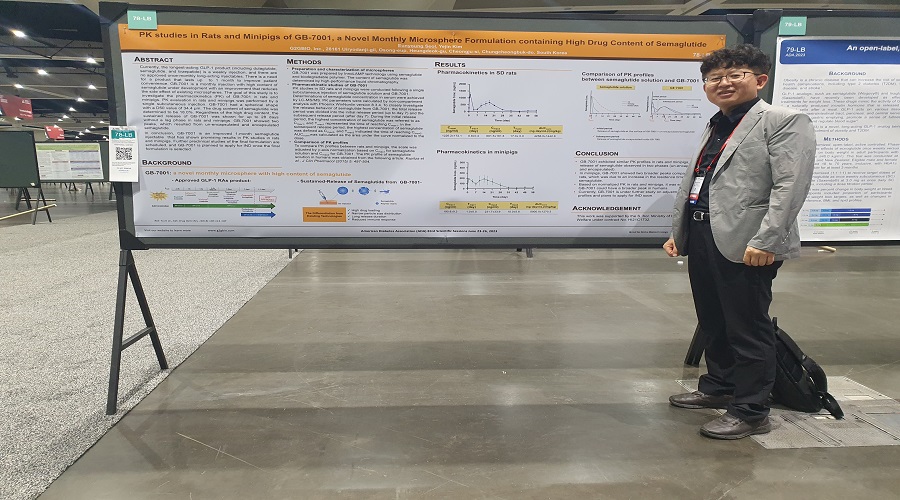Press Release
G2GBio has the best experts in the field of innovative improved injectable drug development.
|
"G2GBio Announces Once-Monthly Semaglutide (GB-7001) Development Results at American Diabetes Association"
2023.06.29
HIT 508
|
|---|
|
"G2GBio Announces Once-Monthly Semaglutide (GB-7001) Development Results at American Diabetes Association"
- Confirmed maintenance of a certain concentration of the active substance in the body for 28 days - Significant improvement in injection site inflammation - Noteworthy research results presented at the American Diabetes Association (ADA) conference
At the 83rd American Diabetes Association (ADA) held in San Diego, California from the 23rd to the 26th, G2GBio announced noteworthy research results related to diabetes and obesity treatments utilizing GLP-1 analogues.
Among diabetes and obesity treatments utilizing GLP-1 analogues, the leading product is Ozempic, a once-weekly semaglutide injectable formulation that achieved annual sales of $10.8 billion last year. Ozempic is a highly successful product developed by Novo Nordisk, contributing to the company's current market cap of $358.9 billion, making it the third-largest global pharmaceutical company.
The key factor driving the growth of GLP-1 sales is the improvement in administration convenience. Early products like Victoza and Byetta, which required daily subcutaneous injections, faced inconvenience. However, with the development of once-weekly injectables such as Trulicity, Ozempic, and Wegovy, which offer improved administration convenience, the GLP-1 market has experienced substantial growth. For chronic conditions like diabetes and obesity that require long-term management, the market for GLP-1 is expected to grow even more with the enhancement of administration convenience for patients. As patient adherence to medication improves, the GLP-1 market is projected to grow rapidly.
Currently, there is growing anticipation in the market for long-acting formulations that extend beyond the once-weekly products, which have seen significant success. Many stakeholders expect that once formulations with durations longer than one month are developed, they will gain a competitive edge over the existing once-weekly injectables.
According to the poster presentation by G2GBio at the ADA conference, the microspheres containing high drug loading of 18% were subcutaneously injected into rats and mini-pigs. Afterwards, the drug's concentration in the bloodstream was observed. The findings showed that there was no rapid initial release, and the drug maintained a steady concentration at or above the desired level for 28 days, with continuous release, remaining in the body for nearly two months.
The 18% drug loading within the microspheres presented by G2GBio at this conference is evaluated to have excellent global competitiveness when considering that the commercialized first-generation GLP-1 analogue microspheres, 'Bydureon,' have a drug loading of 5%, and competitors' products are at 10% or below.
As the drug loading within the microspheres increases, the drug's bioavailability also improves, allowing for maintaining a consistent drug concentration in the body with a smaller amount of microspheres. Therefore, the manufacturing technology for highly drug-loaded microspheres becomes a key factor in the commercialization of microspheres, as it can significantly enhance patient medication adherence.
In addition to the technology for microspheres with inhibited initial bursts and high drug loading, injection site inflammation, which occurs in almost all microsphere injectables, is a significant obstacle to the commercialization of microspheres. According to G2GBio's second poster presentation at the ADA, the semaglutide microspheres (GB-7001) showed a significant reduction in injection site side effects compared to regular microspheres. This improvement in injection site reactions was observed not only in microspheres without the drug but also in microspheres containing tirzepatide, a similar diabetes treatment to semaglutide (the active substance in Eli Lilly's once-weekly injectable, "Mounjaro").
The company stated that the two core technologies presented by G2GBio at this conference not only attracted the interest of global pharmaceutical companies but also significantly increased the possibility of technology transfer and commercialization of the once-monthly long-acting injectable.
G2GBio's CEO, Lee Heeyong, stated, "We have recently completed the construction of a pilot manufacturing facility capable of producing up to 20 kg per batch (equivalent to approximately 400,000 vials of once-monthly diabetes treatment) based on microsphere standards, and we are now entering the scale-up phase for global commercialization." He further added, "In January of this year, we signed a Collaboration Agreement with a global pharmaceutical company for long-acting diabetes treatment, and we are currently in discussions regarding the contractual terms and technical assessments for global technology transfer." |


